
Products
DJI Air 3 vs DJI Air 2S vs DJI Mavic 3 Pro
In-depth comparison between the DJI Air 3, DJI Air 2S, and the Mavic 3 Pro. Find out which DJI camera drone is best for you. ... Read More
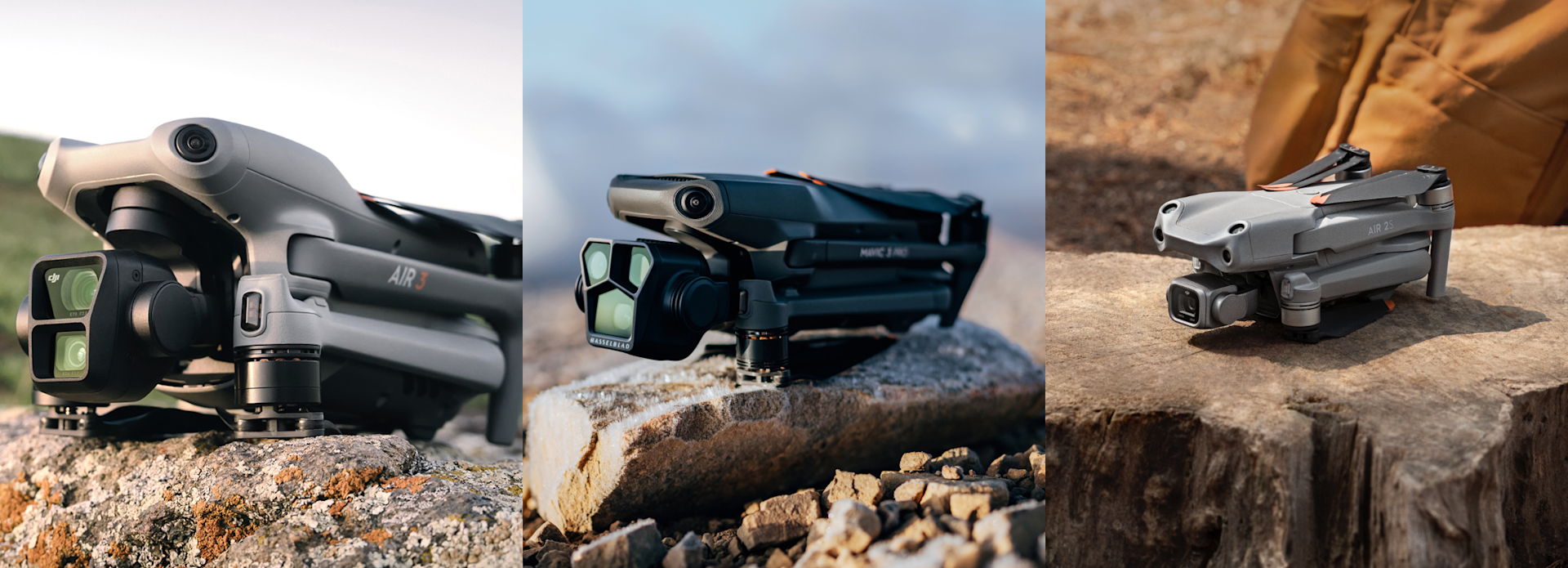
In-depth comparison between the DJI Air 3, DJI Air 2S, and the Mavic 3 Pro. Find out which DJI camera drone is best for you;
DJI Mavic 3 Pro has triple sensors; DJI Air 3 has two cameras; and DJI Air 2S has a single sensor;
Achieve a maximum of 5.1K @ 50fps video with Mavic 3 Pro, 5.4K @ 30fps with Air 2S, and 4K @ 100fps with the Air 3;
Mavic 3 Pro's cameras are 48MP (1/1.3" CMOS), 20MP (4/3 CMOS) and 12MP (1/2" CMOS); Air 3's two 1/1.3" CMOS sensors are 48MP; and the Air 2S' 1" CMOS sensor is 20MP;
DJI Air 3 has a maximum flight time of 46 minutes, compared to the Mavic 3 Pro's 43 minutes and 31 minutes on the Air 2S.
DJI has unveiled its latest camera drone: The DJI Air 3.
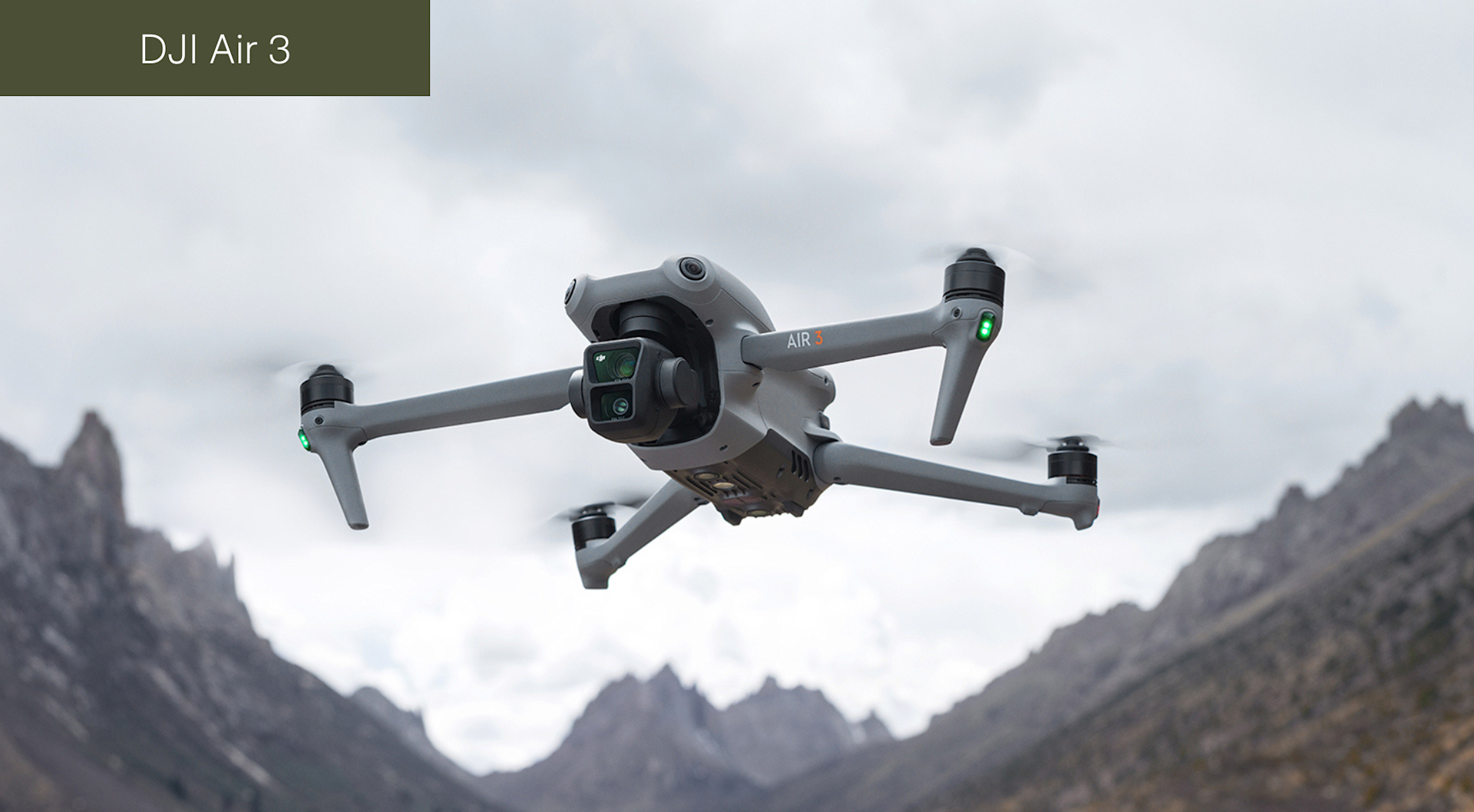
Engineered with a dual imaging system, 46 minutes of flight time, upgraded transmission, and new controllers, this camera drone has some impressive features.
So, how does it compare to the previous Air drone, the DJI Air 2S, and is it worth an upgrade?
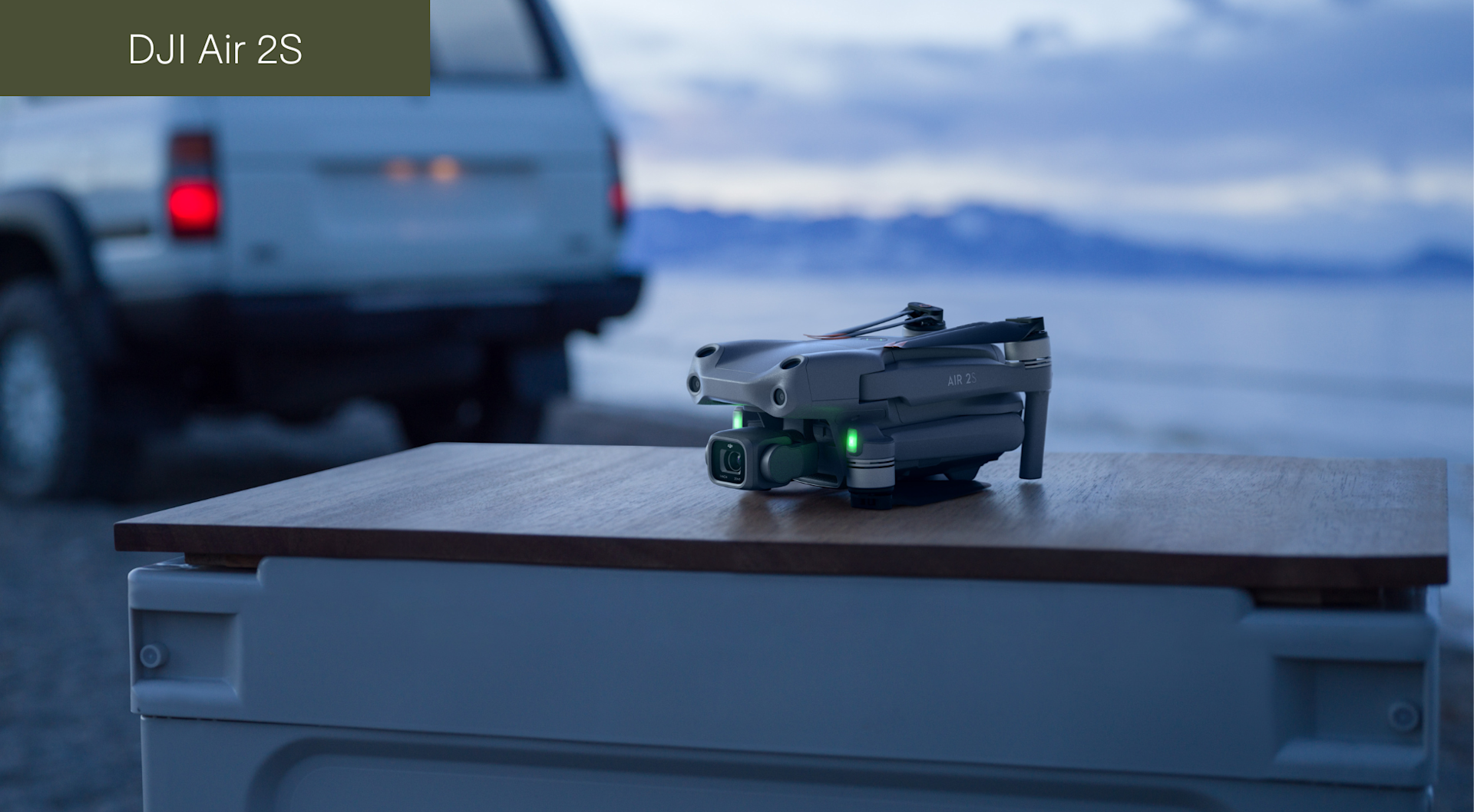
And where does the Air 3 sit compared to the recently-released Mavic 3 Pro? Find out in this in-depth comparison blog.
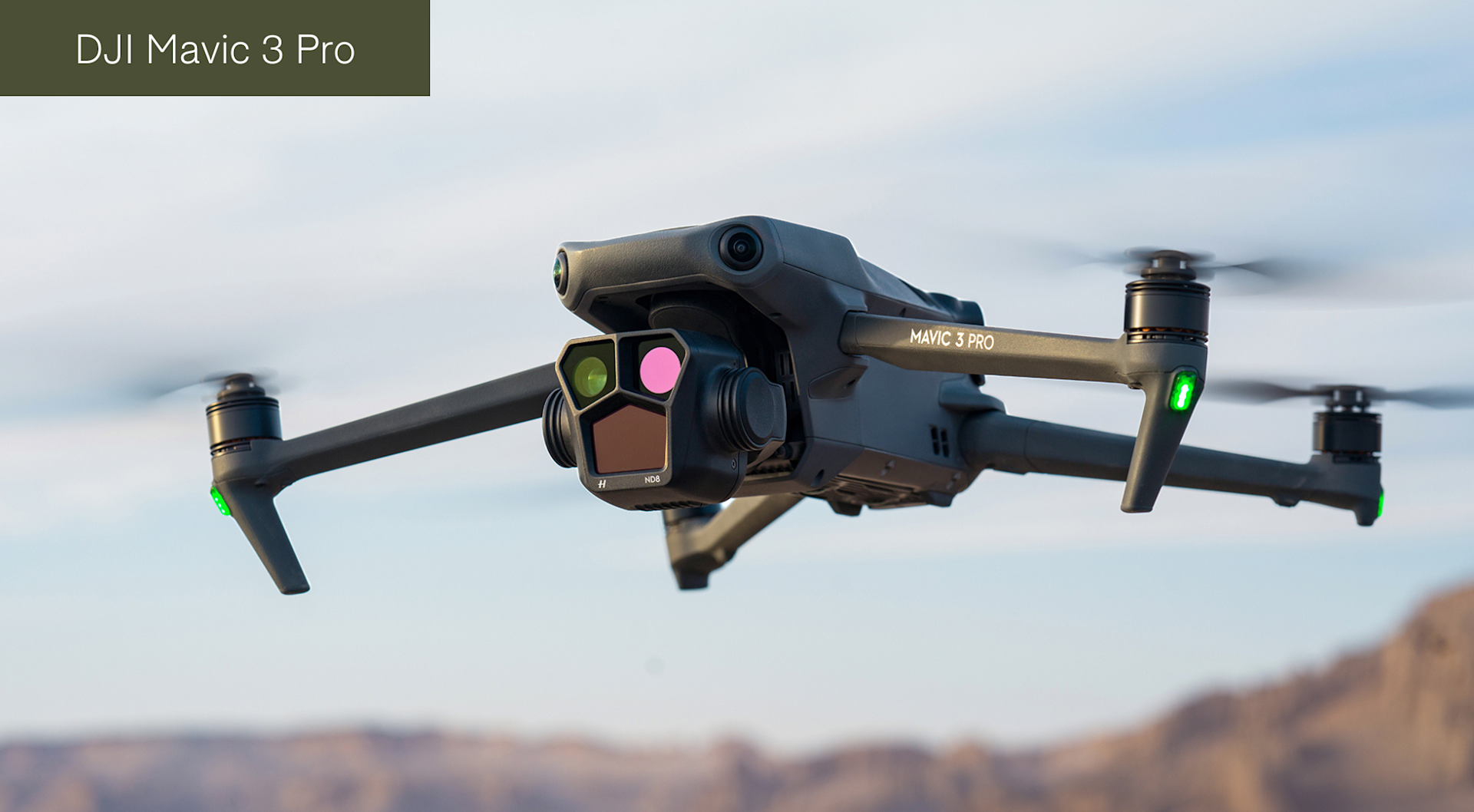
For reference, the Mavic 3 Pro Cine (which has Apple ProRes capabilities and extra built-in storage) is not included in this versus blog, as we felt that the Cine is geared towards a different audience (professional filmmakers/top-end production houses) compared to the standard Mavic 3 Pro, Air 3, and Air 2S, which are more suited towards recreational and amateur content creators.
Read our Mavic 3 Pro (including Cine) vs Mavic 3 Vs Mavic 3 Classic for a detailed comparison between the Mavic 3 Pro and Mavic 3 Pro Cine.
DJI Air 3 vs DJI Air 2S vs DJI Mavic 3 Pro: Key Specifications
This table provides an at-a-glance overview of the key specifications between the DJI Air 3, DJI Air 2S, and the DJI Mavic 3 Pro.
Air 3 | Air 2S | Mavic 3 Pro | |
Weight | 720g | 595g | 958g |
Number of cameras | 2 | 1 | 3 |
Max Video Resolution | 4K/100fps | 5.4K/30fps | 5.1K/50fps |
Max Effective Pixels | 48MP | 20MP | 48MP/ 20MP / 12MP |
Colour Profiles | D-Log M/HLG | D-Log M/HLG | D-Log/D-Log M/HLG |
Obstacle Sensing | Omnidirectional | Front, rear, up, down | Omnidirectional |
Transmission (CE) | O4; 10km | O3; 8km | O3+; 8km |
Flight Time | 46 minutes | 31 minutes | 43 minutes |
Charging Time | 60 minutes | 95 minutes | 70 minutes |
Max Takeoff Altitude | 6,000 m | 5,000m | 6,000m |
Max Takeoff and landing speeds | 10 m/s | 6 m/s | 8 m/s; 6 m/s |
Flight Speed | 21 m/s | 19 m/s | 21 m/s |
The Camera
The DJI Air 3, DJI Air 2S, and DJI Mavic 3 Pro are engineered for content creation - so let's compare the imaging system on each drone.
First off, the Air 3 has a double sensor array, compared to its predecessor's single imaging system, but the Mavic 3 Pro features three cameras.
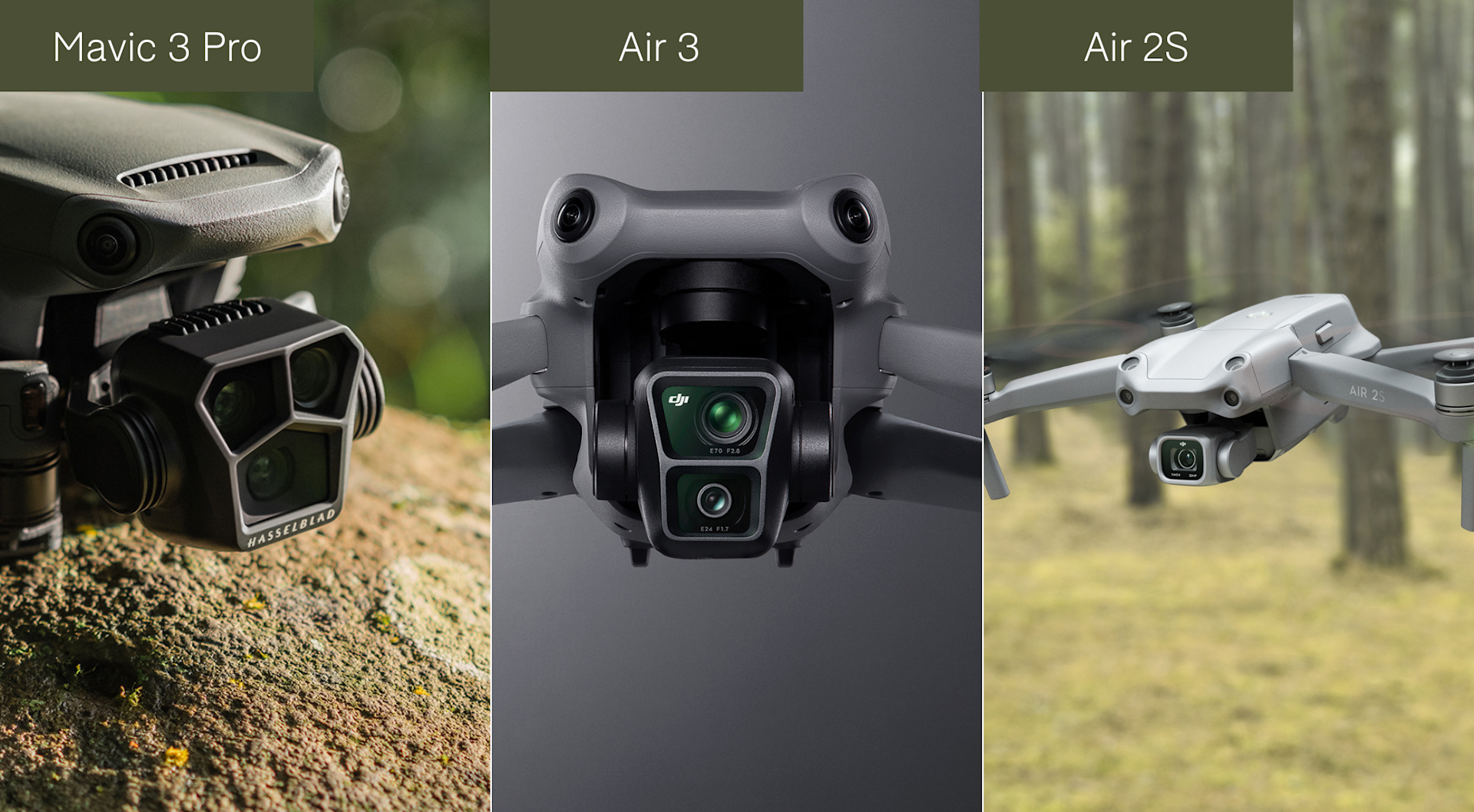
The table below provides a breakdown of these sensors.
DJI Air 3 | DJI Air 2S | DJI Mavic 3 Pro | |
Lens | 1/1.3-inch CMOS Wide-Angle Camera * 48MP * FOV: 82° * 24mm Format Equivalent * Aperture f/1.7 1/1.3-inch CMOS Medium-Tele Camera * 48MP * FOV: 35° * 70mm Format Equivalent * Aperture f/2.8 | 1-inch CMOS Wide-Angle Camera * 20 MP * FOV: 88° * 35 mm Format Equivalent: 22 mm * Aperture: f/2.8 | 4/3 CMOS Hasselblad Camera * 20MP * FOV: 84° * Format Equivalent: 24mm * Aperture: f/2.8-f/11 1/1.3-inch CMOS Medium-Tele Camera * 48MP * FOV: 35° * Format Equivalent: 70mm * Aperture: f/2.8 1/2-inch CMOS Tele Camera * 12MP * FOV: 15° * Format Equivalent: 166mm * Aperture: f/3.4 |
Video Resolution | Wide-Angle & Medium Tele Camera * 4K/60fps HDR * 4K/100fps (slow motion) | Wide-angle Camera * 5.4K/30fps * 1080p/120fps | Hasselblad Camera * 5.1K/50fps * DCI 4K/120fps Medium Tele/Tele Camera * 4K/60fps |
Colour Mode | D-Log M/HLG | D-Log M/HLG | D-Log/D-Log M/HLG |
Photo Format | JPEG/DNG (RAW) | JPEG/DNG (RAW) | JPEG/DNG (RAW) |
Video Format | MP4 (MPEG-4 AVC/H.264, HEVC/H.265) | MP4/MOV (H.264/MPEG-4 AVC, H.265/HEVC) | MP4/MOV (MPEG-4 AVC/H.264, HEVC/H.265) |
Max Video Bitrate | 150 Mbps | 150 Mbps | Hasselblad Camera * 200 Mbps Medium Tele Camera & Tele Camera * 160 Mbps |
Digital Zoom | Wide-angle Camera * 1-3x Medium Tele Camera * 3-9x | Ranging from 4x at 4K/30fps to 8x at 1080p/30fps | Hasselblad Camera * 1-3x Medium Tele Camera * 3-7x Tele Camera * 7-28x (Only in Normal Video Mode and Explore Mode) |
Looking at the table, it's clear that the Mavic 3 Pro is a seriously impressive bit of kit, with its triple-camera array, including that stellar 4/3 CMOS Hasselblad sensor which can capture 20MP imagery and up to 5.1K/50fps video.
The hybrid set up can reach up to 28x zoom to provide immersive rich image details, while the three-camera set-up enables operators to incorporate distinct composition styles for different scenarios in a more efficient way - as this set of images show.

The Air 3 goes someway to replicating this with its dual-camera design - embedding a 1/1.3-inch wide-angle sensor and a 1/1.3-inch tele camera with different focal lengths, delivering consistent image quality and more dynamic imaging possibilities.
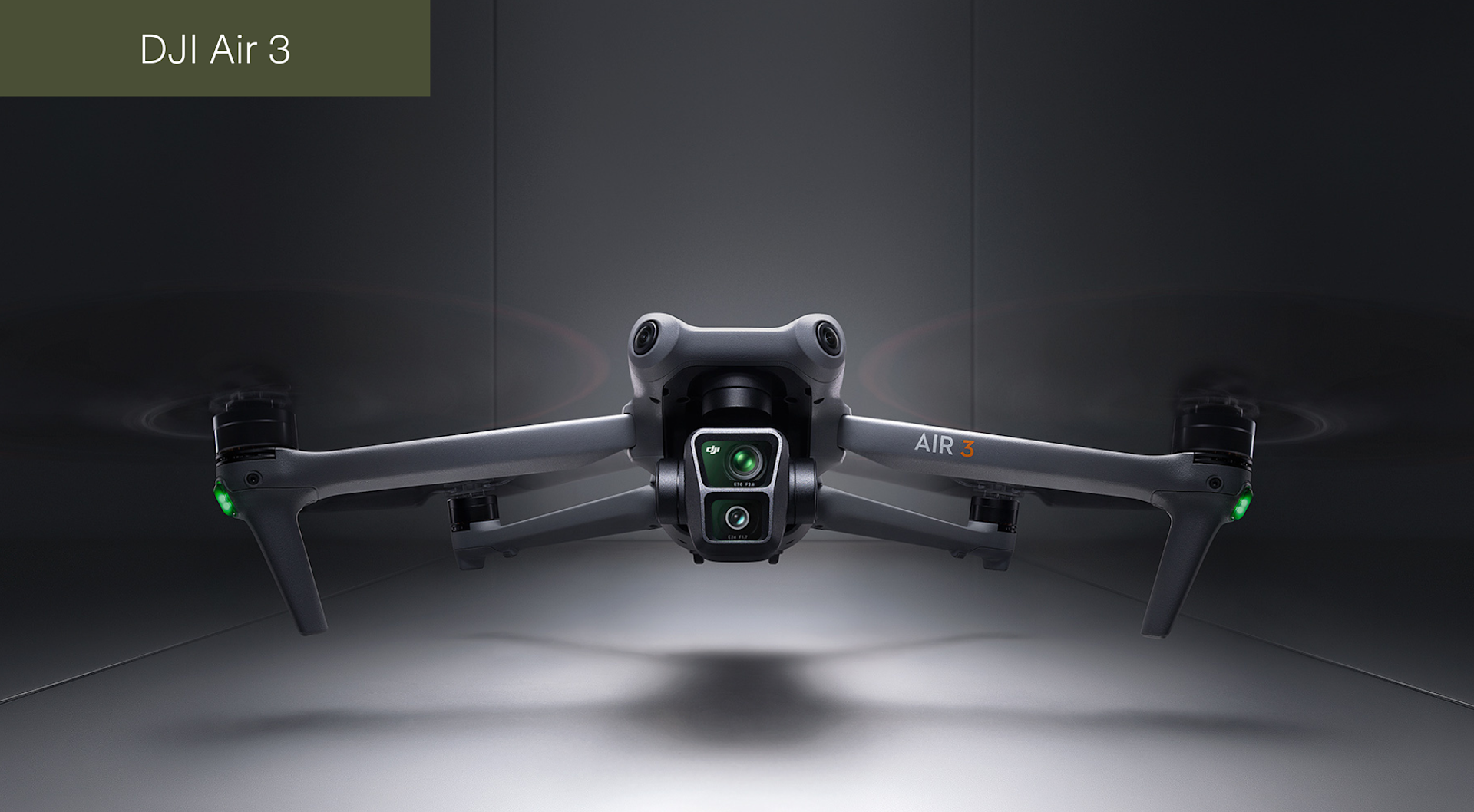
This is a step-up from the Air 2S, with its single camera build, however, the Air 2S does feature a larger single sensor and has the ability to shoot 5.4K/30fps, compared to the Air 3's max 4K/60fps capabilities. However, between the Air 2S and Air 3, there is a toss up of whether content creators need to upload 5K-worth of footage onto platforms like YouTube or social sites, or in fact, the Air 3's 4K will suffice.
On the social front, the Air 3 supports 2.7K vertical shooting with both cameras, delivering clips that are optimised for smartphone viewing and ready to share on social media without any cropping needed in post.
Performance
The Air 3, Air 2S, and Mavic 3 Pro are all stacked with impressive flight performance features.
Flight Time
For compact drones, the Air 3, Air 2S, and Mavic 3 Pro come with some impressive endurance.
At the top of the tree is the Air 3, with a phenomenal 46 minutes of maximum airtime.
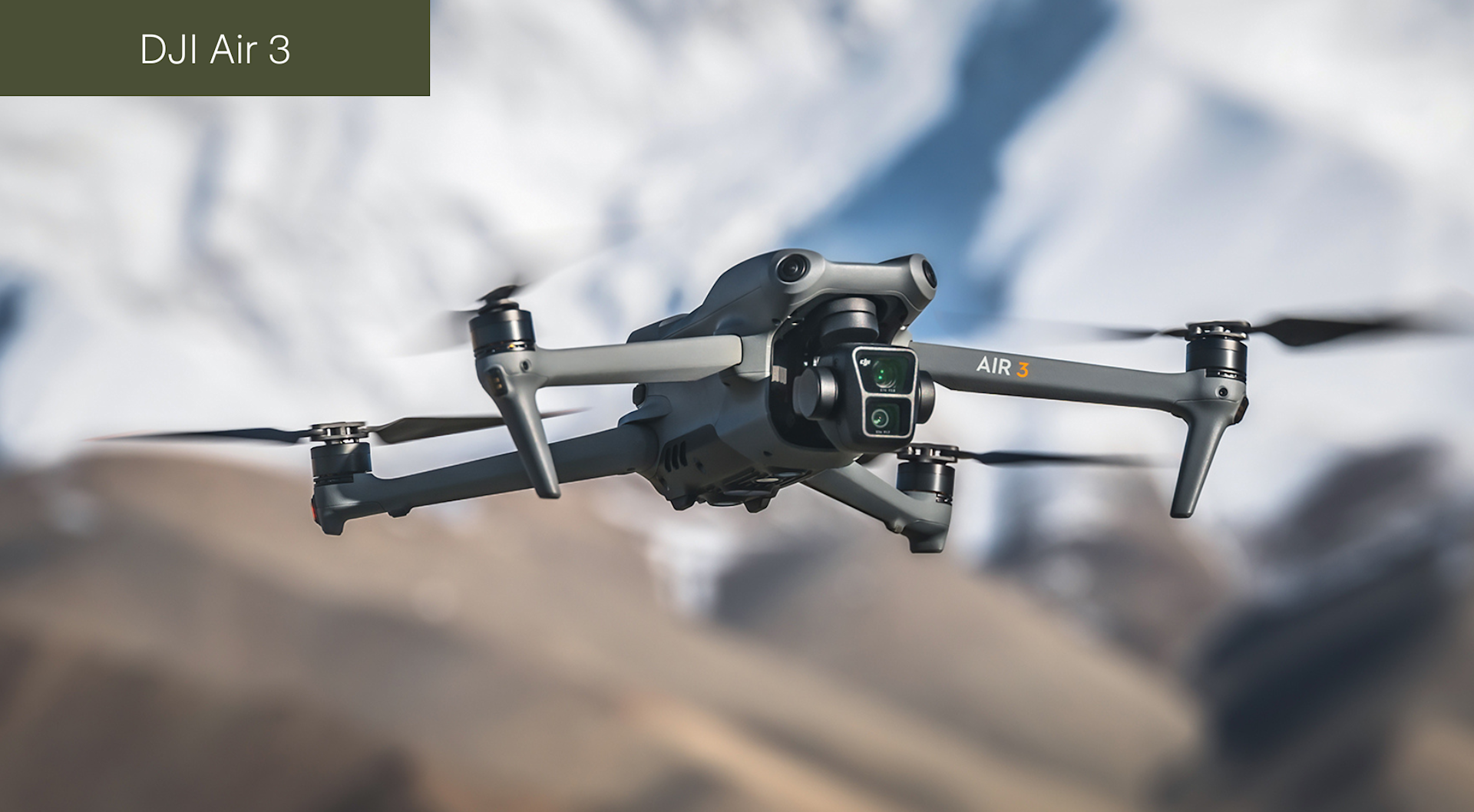
This is one of the stand-out upgrades compared to the Air 2S, which has a maximum flight time of 31 minutes.
The Mavic 3 Pro also impresses in this department, managing to stay airborne for up to 43 minutes.
DJI Air 3 | DJI Air 2S | Mavic 3 Pro | |
Maximum Flight Time | 46 minutes | 31 minutes | 43 minutes |
Maximum Hovering Time | 42 minutes | 30 minutes | 37 minutes |
Maximum Flight Distance | 32km | 18.5km | 28km |
Speed And Agility
All three drones have a turn of pace about them, and are all fairly agile and nimble movers.
The Mavic 3 Pro and Air 3 can reach up to 21 m/s, which equates to around 46.9mph, while the Air 2S tops out at 19 m/s (42.5mph).
It's worth noting that DJI mentions that the Air 3's maximum speed is 19m/s in EU regions.
The table below outlines the key performance specs in this department.
Air 3 | Air 2S | Mavic 3 Pro | |
Maximum Flight Speed | 21 m/s 19 m/s (EU regions) | 19 m/s | lklklk |
Maximum Ascent Speed | 10 m/s | 6 m/s | 8 m/s |
Maximum Descent Speed | 10 m/s | 6 m/s | 6 m/s |
Max Service Ceiling Above Sea Level | 6,000m | 5,000m | 6,000m |
Weather-proof
The Air 3, Air 2S, and Mavic 3 Pro do not come with an IP rating, so it is strongly advised not to fly them in the rain.
However, they all have the ability to perform in hot and cold weather, and can handle wind fairly well, with the Air 3 and Mavic Pro 3 able to withstand Level 6 winds, while the Air 2S can cope with Level 5 wind speeds.
DJI Air 3 | DJI Air 2S | DJI Mavic 3 Pro | |
IP Rating | No | No | No |
Operating Temperature | -10°C to 40°C | 0°C to 40°C | -10°C to 40°C |
Max Wind Speed | 12 m/s Level 6: Strong breeze | 10.7 m/s Level 5: Fresh breeze | 12 m/s Level 6: Strong breeze |
Intelligent Modes
The Air 3, Air 2S, and Mavic 3 Pro are stacked with intelligent modes.
In some areas, the Air 3 and Mavic 3 Pro have more up-to-date versions of the smart features, such as ActiveTrack 5.0, compared to the Air 2S' ActiveTrack 4.0.

All three drones are capable of shooting hyperlapses and panoramas, and can utilise MasterShots, which allows the drone to automatically perform diverse camera movements, shoot multiple clips, and then generate a short cinematic video.
A nice feature of the Mavic 3 Pro and Air 3 is Night Shots, for enhanced capture in low-light environments. The Air 3 and Mavic 3 Pro can capture noise-free footage at up to 4K/30fps.
Safety Features
The Air 3, Air 2S, and Mavic 3 Pro are safe and reliable drones.
The Air 3 and Mavic 3 Pro feature omnidirectional obstacle sensing, while the Air 2S has front, rear, up down obstacle sensors.
DJI Air 3 | DJI Air 2S | DJI Mavic 3 Pro | |
Forward | Measurement Range: 0.5-18 m Detection Range: 0.5-200 m Effective Sensing Speed: Flight Speed ≤ 12 m/s FOV: Horizontal 90°, Vertical 72° | Precision Measurement Range: 0.38-23.8 m Effective Sensing Speed: ≤15 m/s Field of View (FOV): 72° (horizontal), 58° (vertical) | Measurement Range: 0.5-20 m Detection Range: 0.5-200 m Effective Sensing Speed: Flight Speed ≤ 15 m/s FOV: Horizontal 90°, Vertical 103° |
Backward | Measurement Range: 0.5-18 m Effective Sensing Speed: Flight Speed ≤ 12 m/s FOV: Horizontal 90°, Vertical 72° | Precision Measurement Range: 0.37-23.4 m Effective Sensing Speed: ≤12 m/s Field of View (FOV): 57° (horizontal), 44° (vertical) | Measurement Range: 0.5-16 m Effective Sensing Speed: Flight Speed ≤ 12 m/s FOV: Horizontal 90°, Vertical 103° |
Lateral | Measurement Range: 0.5-30 m Effective Sensing Speed: Flight Speed ≤ 12 m/s FOV: Horizontal 90°, Vertical 72° | N/A | Measurement Range: 0.5-25 m Effective Sensing Speed: Flight Speed ≤ 15 m/s FOV: Horizontal 90°, Vertical 85° |
Upward | Measurement Range: 0.5-18 m Effective Sensing Speed: Flight Speed ≤ 6 m/s FOV: Front and Back 72°, Left and Right 90° | Precision Measurement Range: 0.34-28.6 m Field of View (FOV): 63° (horizontal), 78° (vertical) | Measurement Range: 0.2-10 m Effective Sensing Speed: Flight Speed ≤ 6 m/s FOV: Front and Back 100°, Left and Right 90° |
Downward | Measurement Range: 0.3-14 m Effective Sensing Speed: Flight Speed ≤ 6 m/s FOV: Front and Back 106°, Left and Right 90° | ToF Measurement Range: 0.1-8 m Hovering Range: 0.5-30 m Vision Sensor Hovering Range: 0.5-60 m | Measurement Range: 0.3-18 m Effective Sensing Speed: Flight Speed ≤ 6 m/s FOV: Front and Back 130°, Left and Right 160° |
This trio of drones feature APAS (Advanced Pilot Assistance Systems) which make it easier to avoid obstacles, obtain smoother footage, and gives a better flying experience. The Air 2S has APAS 4.0, while the Air 3 and Mavic 3 Pro come equipped with the upgraded APAS 5.0.
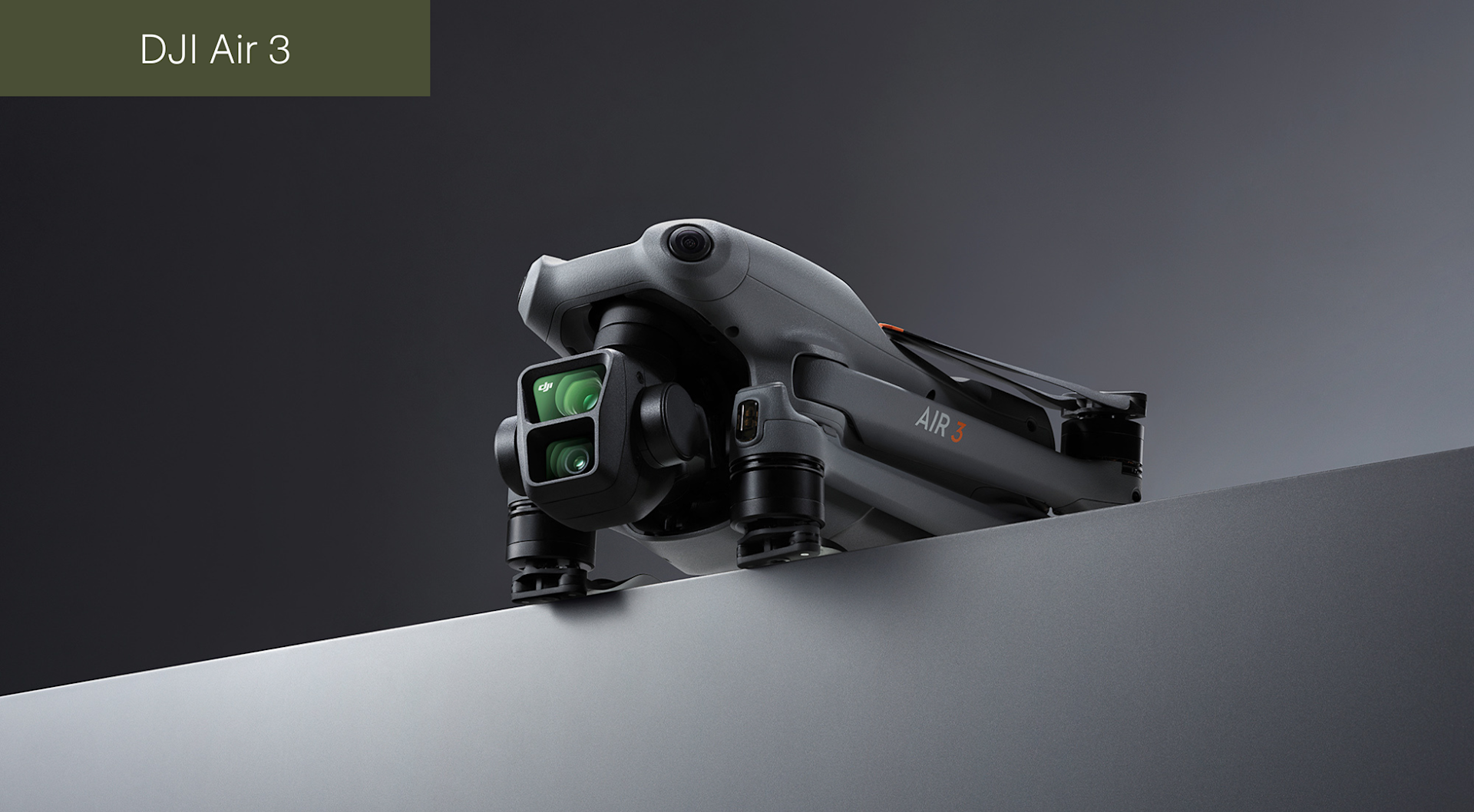
Transmission
One of the headline features of the DJI Air 3 is its compatibility with the new DJI O4 transmission system and its 6 antenna (2T4R) design to stabilise transmission.
This provides strong connections with a maximum transmission distance of 10km (CE).
In contrast, the Mavic 3 Pro - with four antennas (2T4R) and O3+ transmission, and the DJI Air 2S - with four antennas (2T4R) and O3 transmission - have up to 8km transmission distance (CE).
Controllers
The Air 3, Air 2S, and the Mavic 3 Pro can be controlled with a range of RCs - but there are differences in the compatibility.
DJI Air 3: RC-N2 and RC 2
DJI Air 2S: RC Pro, DJI RC, DJI Smart Controller, RC-N1
DJI Mavic 3 Pro: DJI RC Pro, DJI RC, and DJI RC-N1
The DJI Air 3 introduces the new RC 2 and RC-N2 controllers, which are upgraded versions of the DJI RC and RC-N1, and feature a new antenna design and support the O4 video transmission.
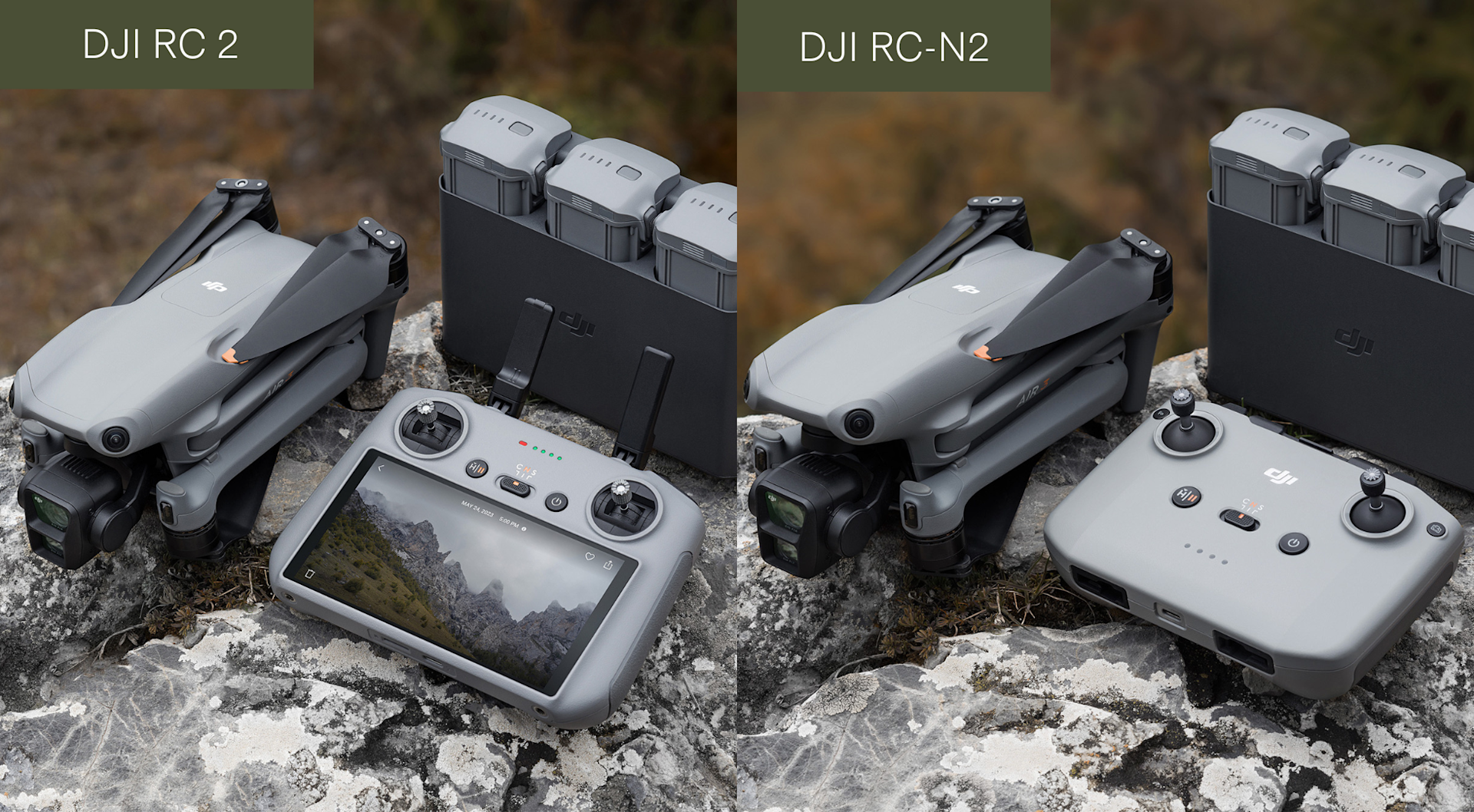
The table below shows the differences and upgrades between the RC 2 and RC-N2, compared to the RC Pro, DJI RC and RC-N1. We haven't included the DJI Smart Controller as it is now end of line, and was essentially replaced by subsequent smart controllers, such as the DJI RC Pro, DJI RC, and now the DJI RC 2.
DJI RC-N2 | DJI RC-N1 | ||||
Number of antennas | 4 antennas (2 TX and 4 RX) | 4 antennas (2 TX and 4 RX) | 2 antennas (1 TX and 2 RX) | 2 antennas (2 TX and 2 RX) | 2 antennas (1 TX and 2 RX) |
Built-in Screen | Yes | Yes | Yes | No: Use with a smart device | No: Use with a smart device |
Operating Time | 3 hours | 3 hours | 4 hours | Not charging mobile device: 6 hours Charging mobile device: 3.5 hours | Not charging mobile device: 6 hours Charging mobile device: 4 hours |
Charging Time | 1.5 hours | 1.5 hours | 1.5 hours | 2.5 hours | 4 hours |
Screen Size | 5.5" | 5.5" | 5.5" | - | - |
Resolution | 1080p | 1080p | 1080p | - | - |
Frames per second | 60fps | 60fps | 60fps | - | - |
Max brightness | 700 nits | 1,000 nits | 700 nits | - | - |
Internal storage | 32 GB | 32 GB | 8 GB | - | - |
Application Installation | Not supported | Supported | Not supported | - | - |
Price
One of the biggest factors for some people will be the price point of each drone.
With its triple-camera array - including Hasselblad camera - and other key features, the Mavic 3 Pro is the most costly of the three drones.
The standard package (with DJI RC) comes in at just under the £2,000 mark, while the Fly More Combos which come with additional accessories, range from around £2,549 with DJI RC to just over the £3,000 bracket with the powerful RC Pro smart controller.
In contrast, the DJI Air 3 hits the market with a lower price tag: The standard package with RC-N2 controller comes in at just under £1,000, while the Fly More Combos range on price, going up to just under £1,400, depending on whether the RC-N2 or RC 2 is selected.
The Air 2S, which is pushing towards end of line, can be purchased for under or around the £1,000 mark, with standard package or Fly More Combos available (both coming with RC-N1 controller).
Summary: DJI Air 3 vs DJI Air 2S vs DJI Mavic 3 Pro
The DJI Air 3 comes hot on the heels of the DJI Mavic 3 Pro, which was released in May.
With its two camera array, alongside extended battery life, upgraded transmission system, and enhanced safety features, the Air 3 is another evolution of the Air Series, and looks set to replace the Air 2S as a mid-sized camera drone for amateur or recreational content creators.
In many ways, the Air 3 ups the ante on the Air 2S, bringing a number of the Air 2S' specs up to the level of the Mavic 3 Pro.
But the key difference between the Air 3 and the Mavic 3 Pro is the camera. And with the Mavic 3 Pro engineered with a triple-camera array, including that beautiful 4/3 CMOS Hasselblad camera, the Pro is a serious bit of kit for creators who want to give their content extra bite - but do not necessarily need the pro-level features of Apple ProRes codec which come with the Mavic 3 Pro Cine and Inspire 3.
